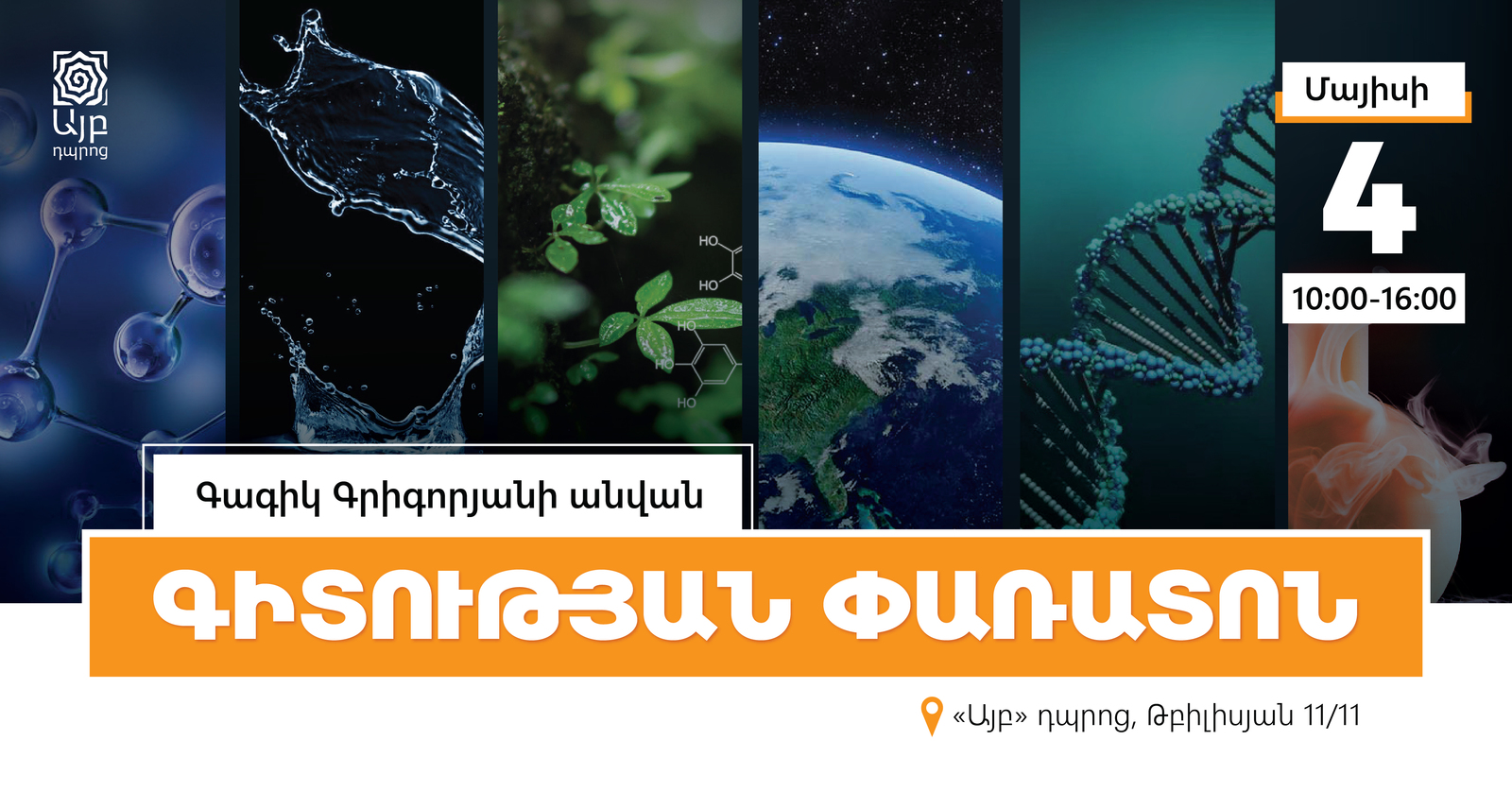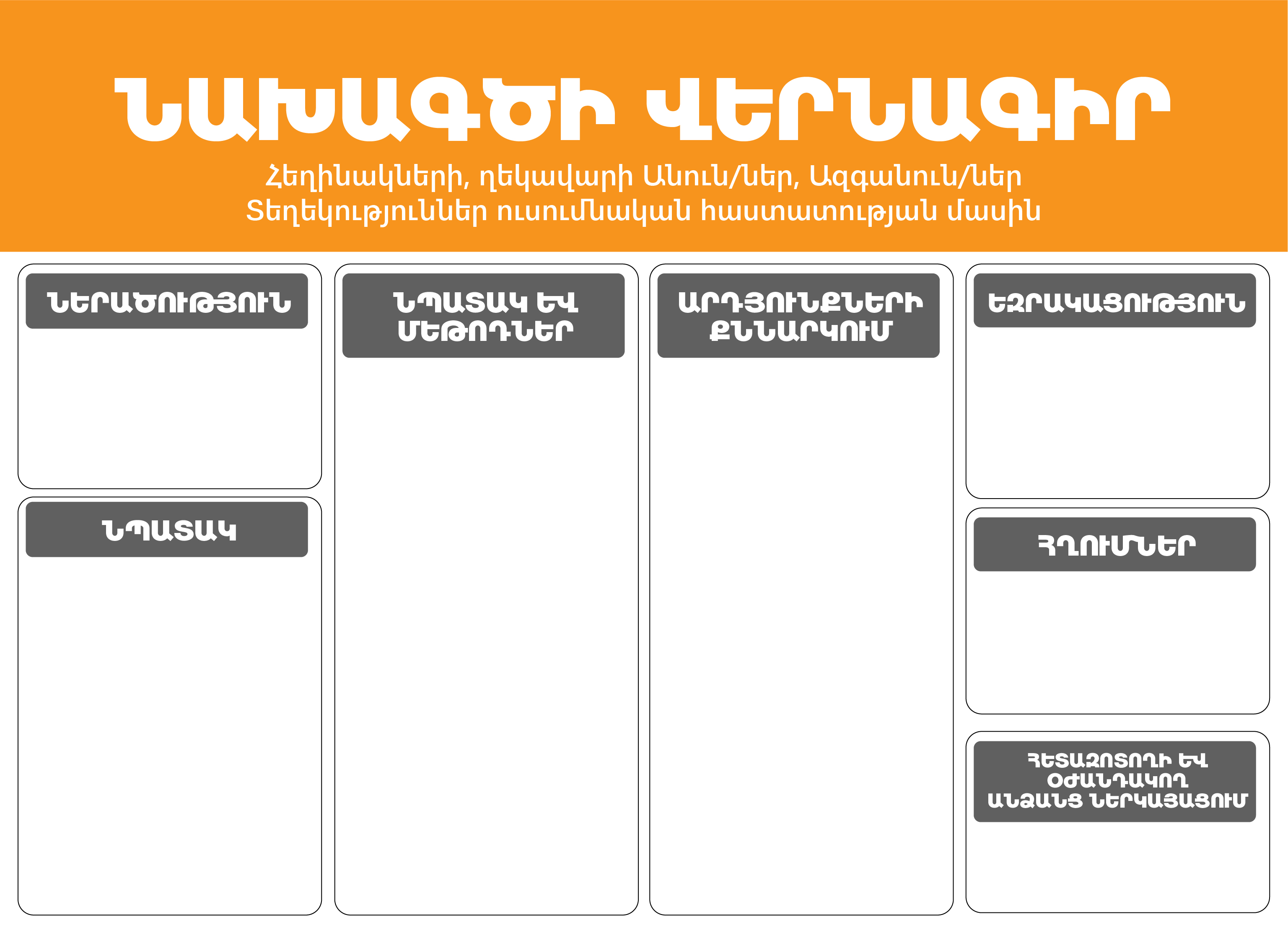
Dear public school students,
As Ayb School launches Gagik Grigoryan Science Festival interschool conference, we invite you to present creative, unique, and innovative projects. Students of elementary, middle, and high schools nationwide are very welcome to submit applications in the following categories:
- Chemistry,
- Physics,
- Biology,
- Geography.
We believe that the conference will help spark schoolchildren's interest in scientific research and provide the opportunity to exchange valuable experiences. The initiative is named to honor our beloved teacher, colleague, and scientist Gagik Grigoryan, who made a major contribution to science and popularized physics for many generations.
The primary goal of the conference is to promote natural sciences by creating an opportunity for school students:
- to gain knowledge about the validity of the scientific method and its limitations and evaluate its applicability in various fields and everyday life;
- to acquire skills to present and defend innovative projects;
- to develop scientific approaches: clarity and accuracy, impartiality, integrity, ability to ask questions, and being proactive;
- to comprehend that the application of science is a collaborative and cumulative process, which is crucial for individuals, society, and the environment.
To be eligible to participate, please apply online by clicking this link. The deadline for submitting applications is April 10, 2024. A separate application must be submitted for every project. The conference will take place on May 4.
- Participants can submit individual or group projects.
- Projects can be presented in the form of an oral or poster report or by conducting an experiment.
- One participant of the conference can present only one project.
- А supervisor can manage more than one project presented at the conference.
- An educational institution can submit more than one project in any category.
- Maximum number of participants in each project: 5 people.
- Duration of one speech: 7 minutes, Q&A session: 3 minutes.
- Individual or group projects accompanied by a written research project report are admitted.
- The report should include brief information on the institution, project, supervisor, and researchers.
- By submitting an application for participation in the conference, the project authors and their scientific supervisors agree to provide the organizers with their personal data for processing and also agree to the publication of news articles and other information about them in printed and electronic form.
- The presented research project must be based on experimental work or theoretical analysis. Students should implement all projects on their own and present the results of their activity. If the work was done in a research laboratory, they should clearly explain their contribution.
- Projects that are purely informative reports or the result of an abstract literature review will not be accepted by the scientific committee and are not eligible to participate.
- Research must be carried out in compliance with labor safety requirements. It should not threaten students’ lives and health or damage the environment.
- Scientific fraud (plagiarism, forgery, use or presentation of other research without proper references, etc.) is unacceptable in written reports and speeches.
- The scientific committee or organizers may reject the application if it does not meet the requirements mentioned above.
• The written report attached to the participation application should be based on the results of independent work carried out using scientific methods and should not exceed one page (see technical requirements below in the next section).
• The relevance of the research subject and tasks outlined in the written report should be proved by analyzing various sources of information, including books, scientific periodicals, magazines, and websites. Researchers must examine other studies and findings on the subject, cite pertinent sources, and clearly communicate their innovative ideas and project goals to present meaningful and productive applications.
• In the theoretical section of the written report, the authors should develop a scientific hypothesis that presumably offers a solution to the issue at hand. To determine whether to accept or reject the hypothesis, they must conduct a scientific experiment and prove that the theory is testable. After that, the data should be examined, and conclusions drawn.
Thus, the written report should generally include the following sections:
- title,
- the first and last name of the author(s),
- the first and last name of the scientific supervisor,
- information about the educational institution (city/village, name, phone number and e-mail address(es)),
- introduction/theoretical analysis,
- purpose
- hypothesis/problem,
- research methods and materials/procedures for conducting scientific experiments,
- discussion/analysis of results obtained from experimental work or theoretical research,
- conclusion,
- presentation of the researcher and assisting persons,
- sources used.
If the above-mentioned requirements are not met, the scientific committee might reject the application.
The written report should meet with the following technical requirements:
- Page size and layout: A4 (210 x 297 mm), top - 1.5 cm, bottom - 1.5 cm, left - 2 cm, right - 1 cm.
- Maximum length: one page, font size: 11 pt, font: Times New Roman, line spacing: single space.
- Title: English, 12 pt font size, uppercase, style: bold, straight, and centered.
- Surnames of the author(s) and supervisor: Latin letters, 12 pt font size, capitalized, style: bold, straight, and centered.
- Information about the educational institution: English, 10 pt font size, uppercase and lowercase, style: italic and centered.
- The symbols, pictures, graphs, schemes, and formulas in all the above sections must be uniform.
- References to sources in all sections should be numbered in square brackets, for example [1]. In the "Sources Used" section, the references should be put according to their sequence in the written report, using 9 pt font size. Sources should be presented as follows.
In the case of an article, the following information is required: author, title, journal (italic), year (bold), volume (issue number), and reference pages.
For instance,
Kim, S., Kim, K. H., Oh, C., Zhang, K., and Park, J. H. Artificial photosynthesis for high‐value‐added chemicals: Old material, new opportunity. Carbon Energy, 2022 4(1), 21-44.
In the case of a book: author, title (italic), publisher, year (bold), and reference page(s).
For instance,
Jonathan Clayden, Nick Greeves, Stuart Warren. Organic Chemistry, 1st edit., Oxford University Press 2002, p. 498.
In the case of using conference materials: author, report title, conference name (italic), conference date and venue, year (bold), and reference page(s).
For instance,
Aleksanyan I.L. Synthesis of a new class of oxadiazoles on the basis of quinoline acetohydrazides. 5th Conference of the Armenian Chemical Society, Yerevan, Armenia, October 3-7, 2017, p. 37.
In the case of a website: the link to the website and the date you accessed it (bold).
For instance,
https://www.intertek.com/chemicals/composition/ 16.09.2022
An overview of the "Resources Used" section
Sources Used
1. Kim, S., Kim, K. H., Oh, C., Zhang, K., and Park, J. H. Artificial photosynthesis for high‐value‐added chemicals: Old material, new opportunity. Carbon Energy, 2022 4(1), 21-44.
2. Jonathan Clayden, Nick Greeves, Stuart Warren. Organic Chemistry, 1st edit., Oxford University Press 2002, p. 498.
3. Aleksanyan I.L. Synthesis of a new class of oxadiazoles on the basis of quinoline acetohydrazides. 5th Conference of the Armenian Chemical Society, Yerevan, Armenia, October 3-7, 2017, p. 37.
4. https://www.intertek.com/chemicals/composition/ 16.09.2022
Poster size: A1 (594 x 841 mm, Whatman).
* Posters of larger or smaller sizes will not be accepted.
You can do a Google search to download free scientific poster templates by inputting the ‘scientific or research poster free template’ keywords into the search bar. Here is an example of a search result.
https://www.posterpresentations.com/free-poster-templates.html
The following table can serve as an example.

- Experiments submitted for demonstration at the conference must be engaging and comprehensible.
- The report should explain the purpose of the experiment and the description of its conduction method and expected benefits.
- The experiment report should meet the technical requirements for poster reports, provided it is presented verbally and does not exceed one page.
Dear participants, the written report you submit to participate in the conference is a short document that aims to capture the reader’s interest in your research. If the report is badly written or has content inconsistencies, the reader will not take the time to examine it. Therefore, you should first of all grab the reader's attention by providing a succinct yet insightful summary of the subject matter. Another crucial element of the written report is its title. Short, eye-catching headlines are the most effective. It is also important that the title clearly communicates the project idea. In the introduction/theoretical analysis section, you should prove the relevance of your work by answering the following questions.
- How valuable and useful are your conclusions?
You should clearly state the purpose of your work and present the research method(s) you employed to achieve your goals. When presenting the results in the written report, you should provide a brief analysis of the data you obtained. It is important to present the results of your own experimental work or theoretical research. You should end the written report with the conclusion(s) summarizing the results obtained.
We recommend that you make sure your written report includes answers to the following questions:
- Is it well-written in terms of language, grammar, and other aspects?
- Does it engage the readers by telling them what your work is about and why they should read this report?
- Does your report explain how the research was done?
- Are the research results discussed and analyzed in the report?
- Does the report provide a brief summary of the results, i.e. a conclusion?
- Does it meet all the requirements set by the scientific committee?
Contact Us
E-mail: [email protected]
Phone: 093 012015